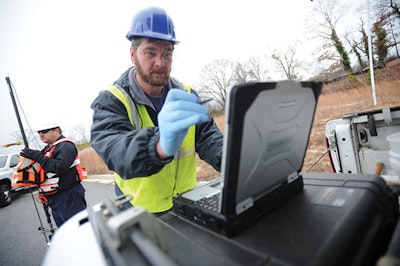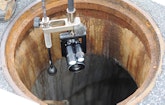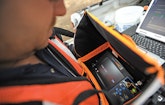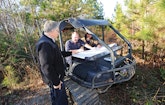
Interested in Trucks?
Get Trucks articles, news and videos right in your inbox! Sign up now.
Trucks + Get AlertsToday's water and wastewater utilities don't lack for data; modern technologies provide scads of it. The key to effective utility management is analyzing and assessing the information and using it to make critical operating and capital investment decisions.
Gwinnett County, Ga., has answered that challenge by creating a field-savvy Operations Technical Services group (OTS) charged with analyzing data, determining priorities and applying the utility's resources in the most cost-effective way.
"Utilities have lots of information," says George Kaffezakis, division director for asset management and support. "The biggest challenge is having people who can analyze the data."
In the case of Gwinnett County, Kaffezakis says the utility's field crews — using GIS and computerized maintenance management — do a good job of gathering information. "But, the issue was 'what were we doing with the data?' " he says. "We had no one on the back end analyzing the information."
With support from senior management and the OTS group in place, Gwinnett County has been able to improve asset management across the board — from more complete identification of attributes, to prioritization of maintenance, to cost reductions on capital improvement projects and more.
Big system
Located in the northeastern part of the metropolitan Atlanta area, Gwinnett County is home to some 800,000 people and has been one of the fastest growing counties in the United States over the last 20 years.
The county's Department of Water Resources represents the merger of separate county water and wastewater departments in the late 1980s. Three wastewater treatment plants serve the area — the F. Wayne Hill Water Resources Center at 60 million gallons per day, the Crooked Creek Water Reclamation Facility at 16 mgd, and the Yellow River WRF, recently expanded from 14.5 to 22.0 mgd. The wastewater collection system includes 2,600 miles of pipe, 225 pumping stations, 280 miles of force mains and over 74,000 manholes.
Three in-house CCTV crews and Video Industrial Services (the County's SSES contractor) inspect about 180 miles of sewer line per year, using CUES equipment and POSM software. County crews use Vactor and Vac-Con trucks to clean lines as necessary, typically 200 to 400 miles per year. For larger pipes, field crews use a Mudmaster (CUES).
The utility conducts its own smoke-testing program and employs a full range of technology — open trench, CIPP, point repairs and pipe bursting — to repair and replace defective sewer pipes. In-house crews are supported in these efforts by contracted services. In 2012, Gwinnett County lined approximately 10,000 linear feet, pipe burst 1,800 feet, and replaced 8,500 feet. "We are looking at bringing additional rehab methods in, such as sliplining, mechanical seals and spiral-wound lining," says Linear Asset Manager Deirdre Blackard.
Epoxy composite is usually the choice for manhole replacement in corrosive parts of the system. Blackard says the utility inspects manholes directly downstream from force main dump manholes and replaces structures that are sufficiently corroded. USPC supplies the replacement manholes and utility crews install them. If crews find only moderate deterioration, the manhole is lined by the utility's contractor.
OTS development
After looking around for good asset management models at other large utilities, the Gwinnett County team formalized asset management as a disciplined process in 2007.
"It was part of our continuous self-improvement plan," Kaffezakis says. "Everyone here was managing assets, but we decided to formalize the process and started a strategic asset management plan for each category of assets — what we were trying to accomplish with each asset, the level of service required, where the information was housed."
More recently, the program has evolved into a tactical plan, enabling the utility to assess the criticality of various assets and prioritize where to spend the utility's resources.
"Our GIS system is very good," Kaffezakis says, "It's foundational — containing all the basic information on what we own and where it's located, and it's available to our operations people in the field."
But beyond linear maintenance management, Kaffezakis points out, the field staff wasn't really using the information. The key to successful asset management at Gwinnett County has been the creation of the OTS group.
"We met with them and asked them what information they used," explains Jeff Boss, the division's director of field operations. He says there was a gap between the information being collected and how it was being used. "No one had time to look at the data," he says.
"The field staff knows what they're doing," Boss explains. "They know how to keep water in the pipes, but asset management ensures that they will figure out the best way of maintaining those pipes."
Enter the OTS
"In our asset management plan, the data comes back to our OTS, not our field people," says Kaffezakis. "We take the data and use it to develop our capital improvement plans, flushing and root control protocols, how best to utilize our resources."
The Gwinnett County team agrees that creating the OTS was their biggest challenge, and has become their biggest success.
"It's not engineering, and it's not capital projects," explains Blackard. "It's several engineers, several technical people and several operational folks all working together."
The group was launched in January 2011 and consists of 12 people supported by FlowWorks, a Web-based platform for flow monitoring data management, and Lucity for CMMS and Condition Assessment data hosting.
Kaffezakis says it's important that the OTS remain close to the operations group. "They're closer to the action and have greater ownership," he says. "It's important that the group stays small, developing tools and processes and optimizing operational practices and processes."
Blackard says OTS is able to work hand-in-hand with the field crews. "They feel invested in it," she says. "We get better information, and it also holds the field personnel accountable."
OTS engineer Steve Sheets says overall, the team is able to provide better guidance to the field crews. He says the creation of a group dedicated to analyzing the data has improved the integrity and completeness of the information coming in from the field. "Our field crews now see that this (the data) does benefit them in the long term."
Good examples
In just over two years since its inception, the OTS concept is producing a handsome return. Better use of field staff time, elimination of redundancies and reduction in costs are measurable benefits, as illustrated by the utility's stream crossing and pipe flushing programs.
"We have over 3,700 stream crossings in our service area," says OTS Manager Rebecca Shelton, referring to points where pipes cross streams. "It's impossible to inspect all of them every year. But using GIS and asset management, we've developed a criticality tool that identifies the consequences of failure and the likelihood of failure, and allows us to inspect the ones requiring more focus and attention — the 500 or so which represent the greatest risk."
The same can be said for pipe flushing. In the past, crews would flush pipes based upon routine rather than determining whether they needed to be flushed or not. Now, however, the condition of the pipe is recorded as it's flushed, and maintenance is scheduled based upon past performance to get crews on-site before a pipe fails or a customer's basement becomes flooded.
It's a proactive approach that costs less in the long run than if the utility were simply reacting to emergencies.
"It's allowed us to stop chasing our tails," says Boss. "We are able to stay ahead of the game, and we actually need fewer people and it's less expensive." Boss says that in 2010 and 2011, the crews inspecting manholes and easements numbered 10 people. Now it's down to four, reduced through retirements and attrition.
But even with fewer people, the utility's preventive maintenance has actually been bolstered through implementation of asset management planning.
"With fewer emergencies, the maintenance staff doesn't get pulled off preventive maintenance any more to respond to crises," Boss points out. "It's PM no matter what. We never have to stop PM to react to emergencies. We couldn't do that before."
Innovations in technology
The asset management approach has also allowed Gwinnett County to take full advantage of available technology and innovations. The crews are using Trimble hand-held GPS units, continuously updating the database as they inspect manholes and gravity mains.
"Last year, we had 7,000 unknown attributes (information on materials and age) on our pipes," says Sheets. "Now we're 99 percent 'known' on our attributes."
Infrastructure systems like these are always subject to corrections, Kaffezakis maintains. "As our GIS people train the field crews, the crews bring new information back to the system and systematically improve it."
Web-enabled trucks are a big help in this effort. "By the end of 2012, every truck contained a laptop computer and a wireless connection, allowing crews to update information and process work orders live from the field," explains Boss. "We're as paperless as we can be at this point."
The system also improves routing efficiency, explains Shelton. "In the past, if we needed to service a house somewhere, we'd send the next available crew, no matter where they were.
"This is a large county," she says, noting that travel distances used to consume lots of fuel. Now they can locate a closer crew and assign them to the call.
"Our idling fuel costs have simply crashed," Boss says. "My fuel expenses are actually down this year. We haven't spent the budget."
Capital improvements
The increased flow and analysis of field data is also helping Gwinnett County get a better grip on capital planning and investment. "It's helping us in the field," says Kaffezakis. "We're analyzing the data, the work orders, and identifying items that need to be repaired or replaced. We're able to prioritize projects that need to be done.
"Everybody's on the same page — engineering, construction," he adds. "We meet with them monthly. We're all in the loop and everyone knows what's going on."
The utility's large number of pump stations provides a good example. "We have 225 pump stations; that's a lot," says Boss. "We were designing a pump station rehab project based on flow, but through smoke testing, we discovered that as much as half the flow we were designing for was coming from infiltration and inflow from private developments."
Poor maintenance on the private side was the culprit, so the utility designed a program to help private developers correct their I&I, and ended up designing smaller pump stations.
Asset management has proven to be an important tool in the utility's effort to decommission some pump stations and reduce their number. Using life cycle costing, the Gwinnett County team has been able to determine when and where it is more cost-effective to obtain easements and run gravity lines into private developments than it is to maintain and operate a force main and pump station.
"We look at the business case costs over a 20- to 40-year time period," Boss says. "We've identified 15 to 20 pump stations slated for decommissioning."
He says the exercise has actually boosted morale among the field crews because these represent force mains and pump stations that won't have to be attended to in the future.
By analyzing operational data and using the life cycle approach, the utility has been able to justify capturing and reusing the digester gas to generate power at one of its treatment facilities. "With stimulus money available for the project, we performed a business case evaluation and found that with or without stimulus funding, the project was worth doing," says Kaffezakis. A 2-megawatt generator has been added to the plant, and a second generator is being considered.
"The upfront capital cost was expensive," says Kaffezakis, but he adds that the long-term cost-benefit ratio was favorable. "It's a smart project, and it's a green project."
Final analysis
So, what's next for Gwinnett County? Not necessarily anything new, according to Kaffezakis. "It's an overused word, but the key is sustainability.
"We need to keep things moving," he notes. "We don't need a lot of new initiatives. We've already implemented a number of them. We need to make sure they have legs, rather than go off in a number of new directions. We need to focus on what we've got."
People are the critical element, in the eyes of the Gwinnett County team.
Boss puts it this way: "You need to make sure you have the right people. We're anticipating the need for more help in our technical group to analyze the information and translate it to field operations."
People are the key to sustaining the program, Boss believes, and Kaffezakis agrees: "If there's one takeaway, it's that asset management requires a serious commitment of people and resources.
"The rewards are certainly worth it, but we often underestimate the effort necessary."
The War on Stormwater
For years, Gwinnett County fought off huge amounts of stormwater overflow at its treatment plant, yet when crews went out to inspect the collections system, they came back with the report that it was tight as a drum.
The problem, explains Jeff Boss, division director of field operations, was that they weren’t getting a very good look at critical lines and manholes in areas that were swampy or wet because they couldn’t get to them.
“Everything looked tight, yet we were getting spikes from the sewer system,” Boss says. “What we found was our crews were using our GIS system to find the manholes at the spots where the wall of water was highest, but were never inspecting them because the areas were too wet to get to.”
That doesn’t happen anymore because Gwinnett County has purchased a pair of ARGO UTVs (ultra-terrain vehicles that can navigate on land or water). They’re amphibious, and frequently used by hunters to navigate flooded areas and move both people and equipment successfully. Boss says once crews got used to the vehicles — he recalls one crew getting washed down river six miles because they hadn’t accounted for the current — they proved to be a great asset.
“We’ve been able to hone in on the manholes in the flooded areas and repair them. We’ve found broken cones, with trees growing out of some of them,” he says. “In some cases, we hadn’t gotten closer than 500 feet from these manholes for more than 17 years.”
In another effort to focus on problem areas, the Gwinnett Operations Technical Services team is using rain gauges. “The flooding is not all over the area,” Division Director George Kaffezakis says. “Using rain gauges helps us get to the basins that need inspection.”
















